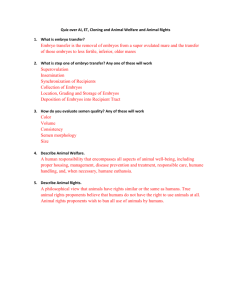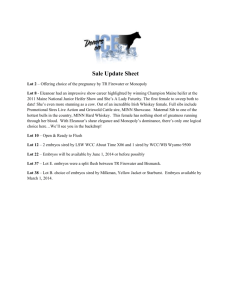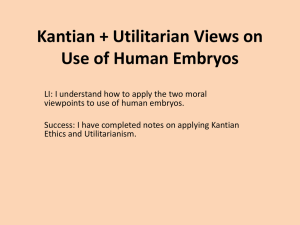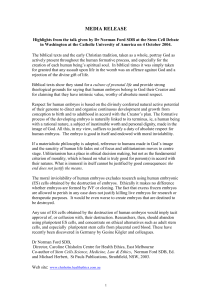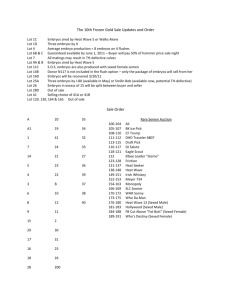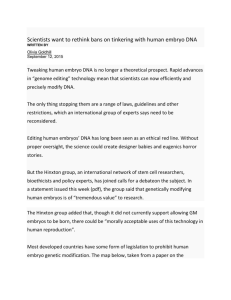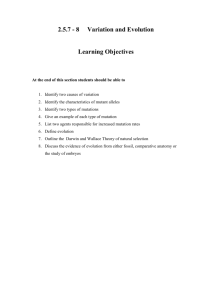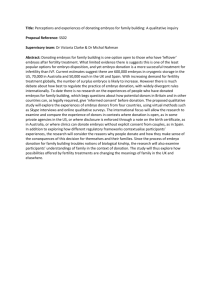supplement
advertisement
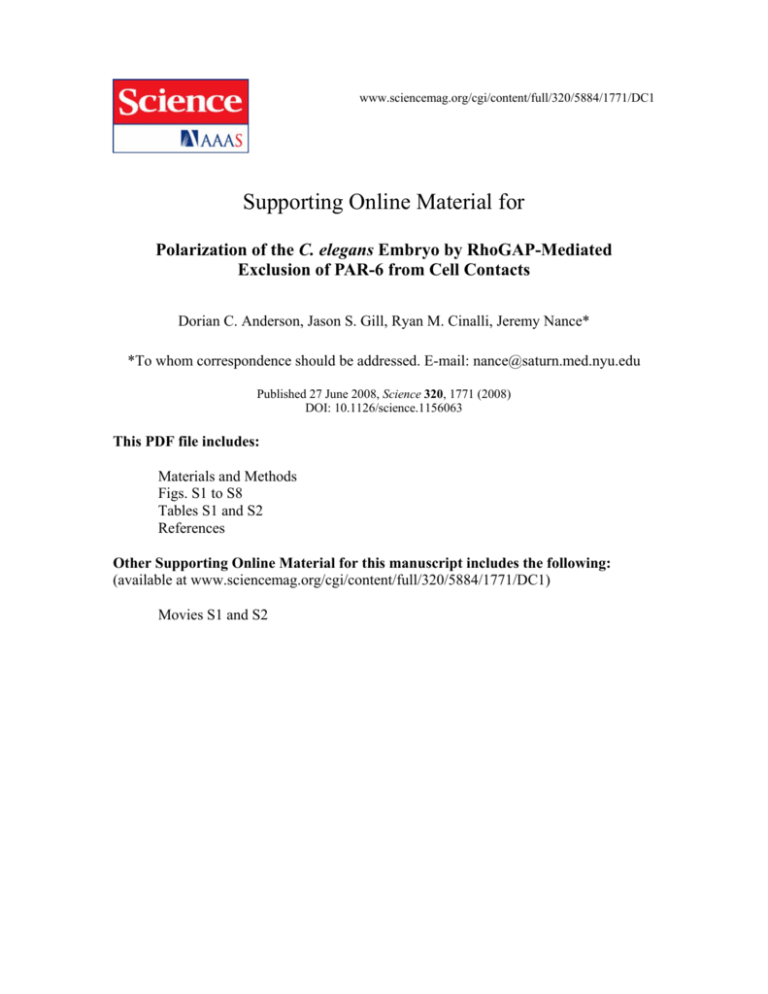
www.sciencemag.org/cgi/content/full/320/5884/1771/DC1 Supporting Online Material for Polarization of the C. elegans Embryo by RhoGAP-Mediated Exclusion of PAR-6 from Cell Contacts Dorian C. Anderson, Jason S. Gill, Ryan M. Cinalli, Jeremy Nance* *To whom correspondence should be addressed. E-mail: nance@saturn.med.nyu.edu Published 27 June 2008, Science 320, 1771 (2008) DOI: 10.1126/science.1156063 This PDF file includes: Materials and Methods Figs. S1 to S8 Tables S1 and S2 References Other Supporting Online Material for this manuscript includes the following: (available at www.sciencemag.org/cgi/content/full/320/5884/1771/DC1) Movies S1 and S2 SUPPORTING ONLINE MATERIAL MATERIALS AND METHODS Strains and mutations par-6(zu222), mIn1[mIs14 dpy-10(e128)], dpy-17(e164), unc-32(e189), and unc119(ed3) are described in WormBase (www.wormbase.org). cdc-42(gk388), isolated by the C. elegans Gene Knockout Consortium, is a small deletion removing basepairs -324 to +154 (ATG = +1) of the cdc-42 gene. The deleted region includes the start codon, part of the essential GTP binding/hydrolysis domain and most of the effector-binding domain and is thus predicted to be a functional null (1). cdc-42(gk388) homozygotes died as larvae (114/115) and lethality was rescued completely by cdc-42::ha-cdc-42 transgene xnIs78. Isolation of pac-1 mutants unc-119(ed3); par-6::par-6-gfp (xnEx12) hermaphrodites were mutagenized with EMS as described and selfed for two generations (2). F3 embryos were scored in utero for PAR-6-GFP localization and mutants were recovered directly from slides. xn1 and xn6 failed to complement, as scored by PAR-6-GFP localization in EES cells (broods from 13 of 13 xn1/xn6 hermaphrodites were Pac). pac-1 mutations showed maternal-effect but not zygotic phenotypes. Immunostaining and fluorescence imaging Embryos were fixed and washed as described (3); an additional five minute fix in 3.7% formaldehyde, 50mM PIPES, 25mM HEPES, 10mM EGTA, and 2mM MgCl2 was included after the methanol fix. The following primary antibodies were used: mouse (ms) α-PAR-3 (4), rabbit (rb) α-PAR-6 (5), rat (rt) α-PKC-3 (6), rb α-GFP (AbCam) (7), rt α-GFP (Nacalai Tesque), ms ‘K76’ (P granules) (8), ms α-HA (Covance). Z-stacks of immunostained embryos were collected using a Zeiss Imager, 63x 1.4 NA objective, Axiocam MRM camera and 300µm between planes. Images were deconvolved using AxioVision, or for HA-CDC-42 were captured as confocal stacks using the Zeiss Apotome. Images shown are maximum intensity projections of several adjacent planes. Unless indicated otherwise, at least 50 embryos at the appropriate stage were scored in each immunostaining experiment. Scoring inner-outer and anterior-posterior polarity Embryos (at the 6-28 cell stage) were considered Pac if outer and inner surfaces of EES cells contained roughly equivalent amounts of PAR-3, PAR-6, PAR-6-GFP, or PKC-3. In pac-1(ZF1) and cdc-42(ZF1) embryos, Pac phenotypes were scored in cells showing no immunostaining of the ZF1-tagged protein. Embryos expressing GFP-PAC-1 from the med-1 promoter were scored at the 12-28-cell stage. For analysis of embryos expressing hsp-16::ha-cdc-42(ca), hsp-16::ha-rho-1(ca), or hsp-16::ha-ced-10(ca) extrachromosomal transgenes, gravid hermaphrodites were heat shocked at 34°C for 1 hour then recovered at 20°C for 45 minutes. Embryos dissected from heat-shocked worms were coimmunostained with HA and PAR-6 antibodies. Those staining for PAR-6 but not HA were considered heat shock controls not carrying the transgene. Inner-outer PAR asymmetry was scored in EES cells of 12-28 cell stage 1 embryos. Likely due to germline silencing, transgene expression was not detected in earlier embryos or in the germline precursor cell. Cleavage furrow position in the zygote was calculated by dividing the distance from anterior pole to cleavage furrow by the egg length. P granule localization, revealed by K76 immunostaining, was used to score embryos for A/P polarity. A/P polarity was considered normal if P granules localized exclusively to the posterior of the zygote or to the germline precursor cell. Localization and quantification of p-rMLC Staining for p-rMLC was performed using a described aldehyde fixation procedure (9) with the following fixative: 4% formaldehyde, 0.2% glutaraldehyde, 3.6% sucrose, 1 mg/ml lysolecithin, 2mM MgCl2, 10mM EGTA, 25mM HEPES (pH 6.9), and 48mM PIPES (pH 6.9). After fixing ten minutes and washing/blocking as described, embryos were incubated overnight at room temperature with 1:100 α-phospho-Myosin Light Chain 2 ser19 antibody (Cell Signalling Technology). To control for variability in fixation and staining, wild-type and pac-1 mutant embryos expressing different gfp transgenes with distinct expression patterns (wild-type expressed med-1::gfp, pac-1 expressed end-1::gfp; (10)) were mixed and processed together in the same tube. GFP expression did not alter p-rMLC immunostaining since wild-type embryos lacking GFP showed equivalent p-rMLC staining. Images were captured as described above. Average pixel intensities over 3.5 - 5.5µm of cortex were calculated using AxioVision software. Ratios were calculated by dividing average p-rMLC intensity at outer surfaces of Ea and Ep by average p-rMLC intensity at outer surfaces of three non-E cells (in AB and MS lineages). Videomicroscopy of gastrulation Timelapse differential interference contrast movies were acquired as described (11). Time zero was defined as the beginning of the 26-cell stage and EPC ingression was considered complete when Ea and Ep or their descendants were completely internalized. Ingression times of the EPCs were 28.5 +/- 3.3 (SD) minutes in wild type (n=7), and 36.4 +/- 2.8 (SD) minutes in pac-1 (n=7) (p < 0.01, one-tailed Student’s t-test). Slowed ingression of the EPCs in pac-1 mutant embryos was not caused by defects in cell cycle length (Ea divided 16.6 +/- 1.6 (SD) minutes (n=7) after the 26-cell stage in wild-type, 17.7 +/- 1.5 (SD) minutes (n=7) in pac-1). Some embryos (13/24) also exhibited blastocoel positioning defects similar to those of embryos lacking PAR-3 or PAR-6 in EES cells (4). Combined embryos Embryos expressing GFP-PAC-1 were treated to remove the eggshell and vitelline membrane, recombined, fixed, and stained with GFP antibodies as described (4). pac-1 cloning and gene structure xn1 and xn6 were mapped to the center of LGIII using single nucleotide polymorphisms (SNPs) and bulk segregant analysis (12); PAR-6-GFP was used to score the Pac-1 phenotype. For high-resolution mapping, xn1 linked to flanking markers dpy-17 and unc119 was crossed to polymorphic strain CB4856; F2 recombinants were homozygosed, 2 genotyped for SNPs, and stained for PAR-3. This analysis positioned xn1 between SNPs C06E1.10728 and ZK1236.9327 (www.wormbase.org). Candidate genes within this interval were screened for Pac phenotypes using RNAi. RNAi of gene C04D8.1 produced a Pac phenotype indistinguishable from pac-1 mutants (see Fig. S3E,F). Mutations within C04D8.1 were identified in both pac-1 mutant alleles (see Fig. S3 legend). Rescue of pac-1 mutants using a C04D8.1-derived cDNA confirmed that pac-1 corresponds to C04D8.1 (Fig. 3B, Table S2). pac-1 transcripts were identified by pairing exonic and SL1 splice leader oligos in RT-PCR reactions primed from mixed-stage RNA (13). Sequencing of cDNAs revealed that the gene structure differed at the 5’ end from the WormBase annotation of C04D8.1 (www.wormbase.org, release WS177, 07/11/2007) and included sequences attributed to predicted upstream gene F42H10.9 (Fig. S3A). In addition to the full-length pac-1 transcript, two additional transcripts were detected: an alternatively spliced transcript lacking exon 8 and a shorter transcript initiated from an internal promoter (Fig. S3A and legend). The transcript lacking exon 8 was sufficient to rescue pac-1 mutants but was not characterized further. RNAi probes targeting the full-length but not short transcript produce phenotypes identical to pac-1 mutations (Fig. S3E,F). RNAi pac-1 RNAi was performed using the feeding method (14). Probe A includes bp 1729 to 2265 of the pac-1 cDNA; probe B was described previously (15) and contains genomic sequences near the 3’ end of pac-1 (clone C04D8.1). zif-1 RNAi was performed as described (16). cdc-42 RNAi was performed by injecting dsRNA from the entire cdc-42 coding sequence into gonads of young adult xnIs3 hermaphrodites as described (17). Transgene construction pac-1 transgenes were produced by Gateway cloning. Full-length pac-1 cDNA amplified by RT-PCR was recombined into pDONR221 (Invitrogen) to create an entry clone, which was recombined into destination vector pID3.01B (18) to create pie-1::gfp-pac-1. pie-1::gfp-pac-1(R984A) was produced in the same manner after mutating the pac-1 entry clone. pie-1::gfp-zf1-pac-1 was constructed using destination vector pJN371, a derivative of pID3.01B containing zf1 coding sequences (19) inserted into the SgrA1 site 3’ of gfp. Both destination vectors also contain the unc-119 gene. cdc-42::ha-cdc-42 and cdc-42::ha-zf1-cdc-42 transgenes were produced from a genomic subclone containing the complete cdc-42 gene, 2774bp of upstream sequence, and 783bp of sequence downstream. An ApaI site was introduced immediately 3’ of the start codon and tandem ha sequences (for cdc-42::ha-cdc-42), or tandem ha sequences followed by the zf1 sequence and an additional ha sequence (for cdc-42::ha-zf1-cdc42), were inserted. unc-119 was added to the vector NotI site as described (4). med-1 transgenes were produced by Gateway cloning. Entry clones were constructed as described above and recombined into destination vector pJN422, which was made by replacing med-1 coding sequences in pMM280 (med-1::gfp-med-1) (10) with Gateway cassette B (Invitrogen). hsp-16::ha-cdc-42(ca), hsp-16::ha-rho-1(ca), hsp-16::ha-ced-10(ca) were produced by Gateway cloning. Entry clone cDNAs of each gene were mutated to forms previously shown to confer constitutively active phenotypes (cdc-42: Q61L; rho-1: 3 Q63L; ced-10: G12V) (17, 20, 21), a restriction site was introduced immediately 3’ of the start codon (EagI or HindIII), and tandem ha sequences were inserted. Each modified entry clone was recombined into destination vector pCD6.09AP, which contains the hsp16-42 promoter, Gateway recombination sequences, and the unc-54 3’ UTR (18). Worm transformation med-1 transgenes were introduced by injecting unc-119 worms as described (22). hsp16::ha-cdc-42(ca), hsp-16::ha-rho-1(ca), and hsp-16::ha-ced-10(ca) transgenes were injected into wild-type worms with the sur-5::sur-5-gfp marker (23). All other transgenes were created using biolistic transformation of unc-119 worms (24). For pac-1 transgenes, pac-1(xn6) unc-119 worms were transformed. For cdc-42 transgenes, cdc42(gk388)/mIn1[mIs14 dpy-10(e128)]; unc-119 worms were transformed. cdc-42 homozygotes were recognized by absence of pharyngeal GFP (expressed from mIs14). Transgene genotypes are listed in Table S1. Quantification of cortical protein enrichment Levels of cortical GFP-PAR-6 and GFP-PAR-6(CM2) were compared in embryos from transgenic lines expressing approximately equivalent amounts of the proteins (as determined by anti-GFP Western analysis on protein extracts from early embryos). Zstacks were acquired and processed as described above using identical camera exposure times. Maximum intensity projections were generated from 2 adjacent planes in which the outer cortex of ABal was in focus. Triplicate, 4µm transects perpendicular to the ABal outer cortex at its most anterior point were drawn and pixel intensities charted along this distance at 0.1µm intervals. Triplicate transects were averaged to give a cortical association profile (CAP). CAPs were averaged for GFP-PAR-6 (n=10) and GFP-PAR-6(CM2) (n=8) and plotted as a function of distance from cell cortex (Fig. S8). Statistical analysis was performed using the Student’s t-test. For quantification of HA-CDC-42 levels, embryos were fixed and immunostained with anti-HA antibodies. Confocal images of 6-cell to 8-cell embryos (wild type, n=3, pac-1(RNAi), n=3) were acquired using a Zeiss Apotome and a plane for analysis was chosen where the outer surfaces of two adjacent AB cells were in focus. CAPs were generated by averaging cortical maxima at outer surfaces of each cell (5 transects per cell) and the inner surfaces where the two cells contacted (10 transects). Ratios were generated between inner and outer cortical association profiles and are presented as the geometric mean. 95% confidence intervals were calculated using the geometric standard deviation. 4 SUPPORTING FIGURES Figure S1. Anterior-posterior PAR asymmetry. Wild-type (A) and pac-1 (B) zygotes costained for PAR-6 and germline P granules. Anterior is left. In pac-1 zygotes, PAR-6 localized appropriately to the anterior cortex (arrows), the zygote cleaved asymmetrically (wild type: 59.3 +/- 2.7% (SD) egg length, n=20; pac-1: 60.1 +/- 2.4 (SD) % egg length, n=20), and germline P granules segregated to the posterior cell and its germline descendants (wild type: 68/68 embryos; pac-1: 66/66 embryos). Bar, 5µm. Figure S2. Quantification of p-rMLC levels. Embryonic stages are indicated on the xaxis; the EPCs in wild type begin to ingress at the onset of the 26-cell stage. y-axis values are ratios of p-rMLC intensity at outer surfaces of the EPCs versus intensity at outer surfaces of non-ingressing cells (see Materials and Methods). Dots indicate individual data points and lines are best-fit curves. Significant differences in p-rMLC levels between genotypes, determined by Student’s t-test of the log-transformed ratios, are indicated. Note that increased levels of p-rMLC at outer surfaces of Ea and Ep could result from active movement of myosin to these surfaces and/or a concentration of preexisting myosin caused by cortical constriction; our data do not distinguish these possibilities. 5 Figure S3. The pac-1 locus and pac-1(RNAi). (A) pac-1 gene structure. Exons are represented with boxes and introns with lines. Untranslated portions of exons are grayed. Approximate positions of the PH and RhoGAP domains are shown. Transcription is initiated from two sites and the 5’ ends of mRNAs from each site are trans-spliced to SL1 (indicated). The full-length transcript contains 19 exons; an alternatively spliced form lacking exon 8 is indicated. A shorter transcript initiates from the internal SL1 site and shares all downstream exons with full-length pac-1. xn1 contains a G to A mutation in the invariant first base of the intron splice donor sequence (intron 14); xn6 contains a C to T mutation converting codon 850 to a stop codon. (B) Protein organization of PAC-1 and its human homologue ARHGAP23. ARHGAP23 and ARHGAP10 are identified as PAC-1 homologues in BLAST searches using either the PH or RhoGAP domain. ARHGAP23 and ARHGAP10 have a similar organization and can include an N-terminal PDZ domain. PAC-1 PH and RhoGAP domains are 47% and 69% similar to those of ARHGAP23, respectively (ARHGAP10 and PAC-1 have similar conservation over these domains). (C) Sequence alignment of a portion of the RhoGAP domain from PAC-1, ARHGAP23, ARHGAP10 and CYK-4. Arginine 984 of PAC-1 is marked with an asterisk. (D-F) Live 8-cell wild-type (D) or pac-1(RNAi) (E,F) embryos expressing PAR6-GFP (arrows). An RNAi probe from a region present in both longer and shorter pac-1 transcripts (probe A, panel E), as well as a probe present in the longer pac-1 transcripts but absent in the shorter transcript (probe B, panel F) both cause PAR-6-GFP to localize symmetrically. Probe positions are indicated over the gene structure in panel A. Bar, 5µm. 6 Figure S4. Functionality of ZF1 fusion proteins. All embryos shown are zif-1(RNAi) embryos, where ZF1-mediated degradation is blocked (16). (A,B) pac-1 embryo expressing GFP-ZF1-PAC-1 and coimmunostained for GFP and PAR-6. PAR-6 developed its normal inner-outer asymmetry (61/63 embryos; arrow in B), indicating that GFP-ZF1-PAC-1 is functional. (C,D) cdc-42 embryo expressing HA-ZF1-CDC-42 and coimmunostained for HA, PAR-6, and P granules. PAR-6 localized to the outer cortex in 53/55 embryos (arrow in D), demonstrating that HA-ZF1-CDC-42 is functional; often, inner-outer PAR-6 asymmetry was somewhat weaker than in wild type. cdc-42 mutants expressing HA-ZF1-CDC-42 were viable and fertile, likely because embryos lacked CDC-42 activity for only a few cell cycles (zygotic expression of cdc-42::ha-zf1-cdc-42 was first detected after the 50-cell stage). Bar, 5µm. Figure S5. HA-CDC-42 localization. (A,B) Confocal images of HA-CDC-42 in cdc-42 (A) or pac-1(RNAi) cdc-42 (B) 7-8 cell embryos. HA-CDC-42 is found at both inner and outer surfaces of early embryonic cells (arrows). In both genotypes, the ratio of averaged cortical maxima of HA-CDC-42 at inner and outer surfaces (R i/o) was similar (wild type: R i/o = 1.07, 95% confidence interval 1.02 – 1.12, n = 3; pac-1(RNAi): R i/o = 1.12, 95% confidence interval 1.02 – 1.23; see Materials and Methods), indicating that HA-CDC-42 localizes independently of PAC-1. HA-CDC-42 was functional since it rescued the lethality of cdc-42(gk388), and cdc-42 embryos expressing HA-CDC-42 showed normal inner-outer PAR-6 asymmetry (30/30 embryos). Bar, 5µm. 7 Figure S6. PAR-6-GFP in cdc-42(RNAi) embryos and GFP-PAC-1 in cdc-42(ZF1) embryos. (A,B) Live 8-cell wild-type or cdc-42(RNAi) embryos expressing PAR-6GFP. Images were captured using identical exposure times. PAR-6-GFP is enriched at the outer cortex in wild type (arrows in A); PAR-6-GFP localizes to the cytoplasm but not cortex in cdc-42(RNAi) embryos and forms some small cytoplasmic puncta. cdc42(RNAi) embryos also lack A/P polarity and have no germ line precursor cell, as described previously (25, 26). (C-D) 26-cell cdc-42(ZF1) embryo (cdc-42; cdc-42::hazf1-cdc-42) expressing GFP-PAC-1. GFP-PAC-1 is still found at inner surfaces of cells lacking HA-ZF1-CDC-42 (arrow). Staining intensity of GFP-PAC-1 is lower in embryos at this stage than those at earlier stages (see Fig. 3C), presumably because the maternally expressed fusion protein is depleted gradually as embryogenesis proceeds. (E,F) 28-cell pac-1(RNAi) cdc-42(ZF1) embryo costained for HA and GFP. Cells where HA-ZF1CDC-42 is not detected lack both PAC-1 and CDC-42, while cells expressing HA-ZF1CDC-42 lack only PAC-1. PAR-6 is present in the cytoplasm of cells lacking both CDC42 and PAC-1, and is enriched at the cortex of cells lacking PAC-1 only. Bar, 5µm. 8 Figure S7. Effect of heat shock, HA-RHO-1(CA) and HA-CED-10(CA) on PAR-6 localization. (A,B) ~24-cell control heat-shocked wild-type embryo (A) or embryo expressing GFP-PAR-6(CM2) (B). The distribution of these proteins is not changed by heat shock, and GFP-PAR-6 localization (arrow) in heat-shocked embryos resembles that of PAR-6. (C,D) Heat-shocked embryo expressing hsp-16::ha-ced-10(ca) and costained for HA and PAR-6. HA-CED-10(CA) did not alter the asymmetry of PAR-6, which was still enriched at outer surfaces of EES cells (arrow in D) (20/20 embryos) (E,F) Heatshocked embryo expressing hsp-16::ha-rho-1(ca) and costained for HA and PAR-6. HARHO-1(CA) caused dramatic defects in cytokinesis (arrowhead indicates multinucleate cell), cell architecture (note cell fragments in center of embryo), and cortical organization (note irregular cortical distributions of HA-RHO-1(CA) and PAR-6, arrow) (18/19 embryos); these phenotypes are consistent with published roles for C. elegans rho-1 in cytokinesis and cytoskeletal organization (5, 27-29). It is unclear whether mislocalization of PAR-6 to cell fragments in central embryonic regions (arrow in F) is caused directly by increased RHO-1 activity or is an indirect consequence of gross cytoskeletal changes induced by RHO-1 misregulation. (G,H) Heat-shocked 24-cell (G) and 12-cell (H) embryos expressing hsp-16::ha-cdc-42(ca) and either GFP-PAR-6 (G) or GFP-PAR-6(CM2). GFP-PAR-6 is enriched at both inner and outer cortices (arrow); GFP-PAR-6(CM2) is present within the cytoplasm and also forms cytoplasmic puncta. Bar, 5µm. 9 Figure S8. GFP-PAR-6 and GFP-PAR-6(CM2) cortical enrichment. The graph depicts averaged cortical association profiles (see Materials and Methods) for GFP-PAR6 (red squares, n=10) and GFP-PAR-6(CM2) (yellow triangles, n=8). Profiles extend from just outside of the cell (negative values), span the cortex (zero, stippled blue line), and extend into the cytoplasm (positive values). SEM error bars are shown. Asterisks designate statistically lower cortical localization of GFP-PAR-6(CM2) (p ≤ 0.05, onetailed Student’s t-test). SUPPORTING TABLES Table S1. Transgenes Genotype (promoter::coding) par-6::par-6-gfp pie-1::gfp-pac-1 pie-1::gfp-pac-1(R984A) pie-1::gfp-zf1-pac-1 med-1::gfp-pac-1 cdc-42::ha-cdc-42 cdc-42::ha-zf1-cdc-42 pie-1::gfp-par-6 pie-1::gfp-par-6(cm2) hsp-16::ha-cdc-42(ca) hsp-16::ha-rho-1(ca) hsp-16::ha-ced-10(ca) Transgene xnEx12 (7), xnIs3 xnEx25, xnIs27, xnIs28 xnIs34, xnIs35, xnIs36 xnIs43 xnEx26 xnIs78 xnIs83 zuIs22 itIs164 (17) xnEx45 xnEx50 xnEx51 10 Table S2. Inner-outer PAR asymmetry in pac-1 embryos Percent with inner-outer Genotype PAR asymmetry (n)* wild type 98.8 % (85) pac-1(xn6) 1.4 % (70) pac-1(xn6); gfp-pac-1 (xnEx25) 91.5 % (47) pac-1(xn6); gfp-pac-1 (xnIs27) 98.4 % (64) pac-1(xn6); gfp-pac-1 (xnIs28) 96.7 % (61) pac-1(xn6); gfp-pac-1(R984A) (xnIs34) 5.3 % (131) pac-1(xn6); gfp-pac-1(R984A) (xnIs35) 7.3 % (41) pac-1(xn6); gfp-pac-1(R984A) (xnIs36) 4.0 % (50) * Scored in 6-cell to 24-cell stage embryos using PAR-3 immunostaining. SUPPORTING REFERENCES 1. 2. 3. 4. 5. 6. 7. 8. 9. 10. 11. 12. 13. 14. 15. 16. 17. 18. 19. 20. 21. D. I. Johnson, Microbiol. Mol. Biol. Rev. 63, 54 (1999). S. Brenner, Genetics 77, 71 (1974). B. Leung, G. J. Hermann, J. R. Priess, Dev. Biol. 216, 114 (1999). J. Nance, E. M. Munro, J. R. Priess, Development 130, 5339 (2003). S. Schonegg, A. A. Hyman, Development 133, 3507 (2006). Y. Tabuse, Y. Izumi, F. Piano, K. J. Kemphues, J. Miwa, S. Ohno Development 125, 3607 (1998). R. Totong, A. Achilleos, J. Nance, Development 134, 1259 (2007). S. Strome, W. B. Wood, Cell 35, 15 (1983). E. Munro, J. Nance, J. R. Priess, Dev. Cell 7, 413 (2004). M. F. Maduro, M. D. Meneghini, B. Bowerman, G. Broitman-Maduro, J. H. Rothman, Mol. Cell 7, 475 (2001). J. Nance, J. R. Priess, Development 129, 387 (2002). S. R. Wicks, R. T. Yeh, W. R. Gish, R. H. Waterston, R. H. Plasterk, Nat. Genet. 28, 160 (2001). T. Blumenthal, in WormBook. The C. elegans research community and WormBook, Eds. (Wormbook, www.wormbook.org, June 25, 2005). R. S. Kamath, M. Martinez-Campos, P. Zipperlen, A. G. Fraser, J. Ahringer, Genome Biol. 2, 1 (2001). R. S. Kamath et al., Nature 421, 231 (2003). C. DeRenzo, K. J. Reese, G. Seydoux, Nature 424, 685 (2003). D. Aceto, M. Beers, K. J. Kemphues, Dev. Biol. 299, 386 (2006). Y. Hao, L. Boyd, G. Seydoux, Dev. Cell 10, 199 (2006). K. J. Reese, M. A. Dunn, J. A. Waddle, G. Seydoux, Mol. Cell 6, 445 (2000). E. A. Lundquist, P. W. Reddien, E. Hartwieg, H. R. Horvitz, C. I. Bargmann, Development 128, 4475 (2001). J. A. Zallen, E. L. Peckol, D. M. Tobin, C. I. Bargmann, Mol. Biol. of the Cell 11, 3177 (2000). 11 22. 23. 24. 25. 26. 27. 28. 29. C. Mello, A. Fire, in Caenorhabditis elegans: Modern Biological Analysis of an Organism H. F. Epstein, D. C. Shakes, Eds. (Academic Press, San Diego, 1995), vol. 48, pp. 452-482. J. Yochem, T. Gu, M. Han, Genetics 149, 1323 (1998). V. Praitis, E. Casey, D. Collar, J. Austin, Genetics 157, 1217 (2001). M. Gotta, M. C. Abraham, J. Ahringer, Curr. Biol. 11, 482 (2001). A. J. Kay, C. P. Hunter, Curr. Biol. 11, 474 (2001). V. Jantsch-Plunger et al., Jour. Cell Biol. 149, 1391 (2000). N. Jenkins, J. R. Saam, S. E. Mango, Science 313, 1298 (2006). F. Motegi, A. Sugimoto, Nat. Cell Biol. 8, 978 (2006). ONLINE MOVIES Movie S1. EPC ingression in a wild-type embryo. EPCs are false-colored. Each timepoint is a DIC micrograph of a single plane. Movie begins at the 26-cell stage and ends after Ea and Ep divide. Timepoints are 1 min apart. Movie S2. EPC ingression in a pac-1 embryo. See Supplemental Movie 1 for description. Unlike in wild type, Ea and Ep divide before they are internalized. 12
